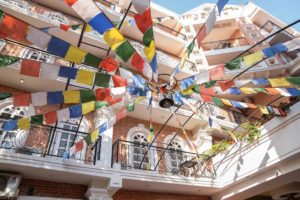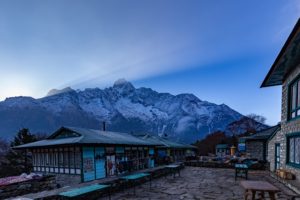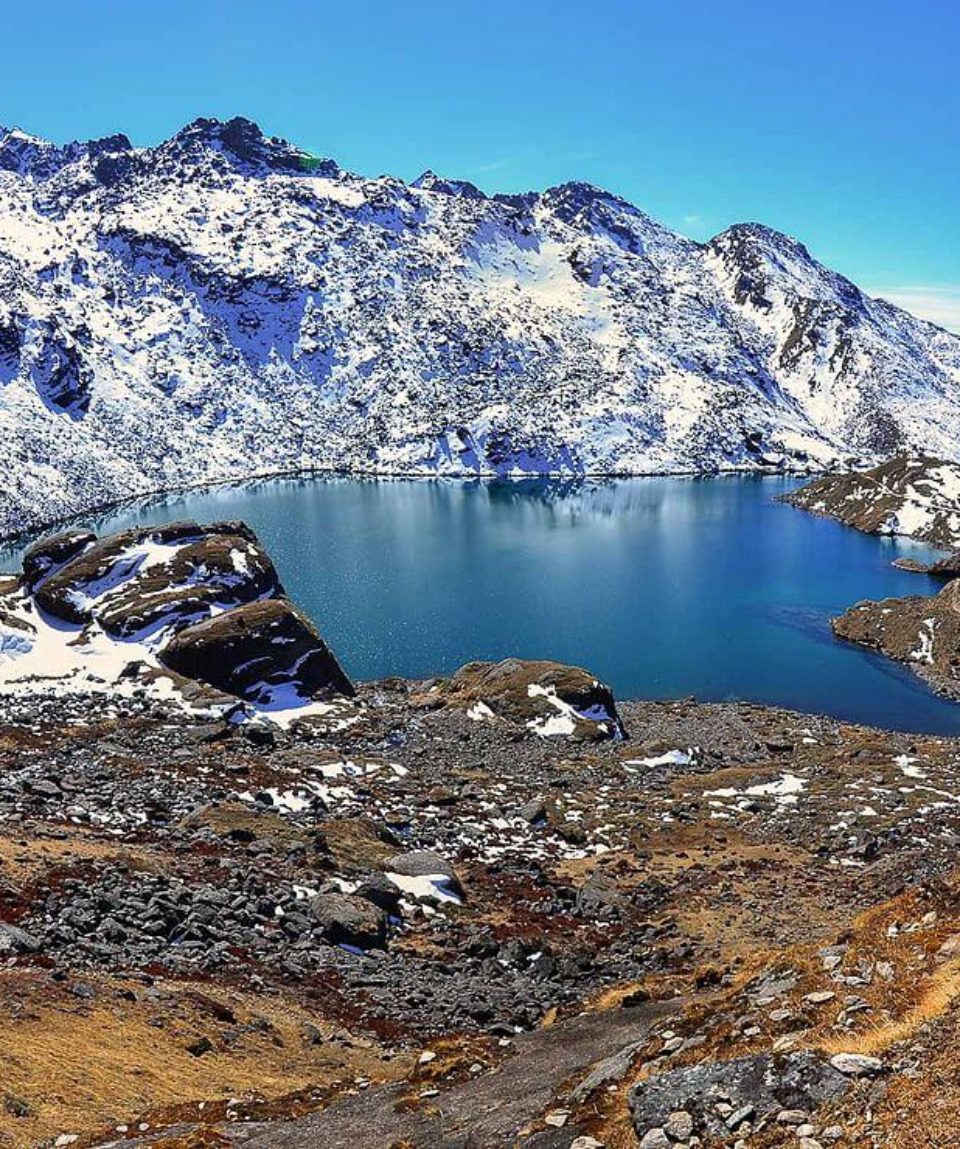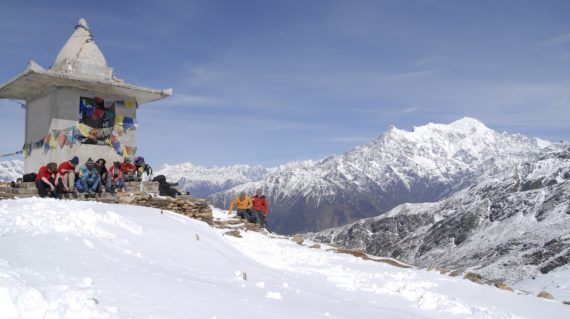
Langtang Gosaikunda Helambu Trekking
fromFor those who are looking for a once-in-a-lifetime nomadic adventure, we have organized the traditional way to tour the entire Langtang Region. Simply put, the Langtang Gosaikunda Helambu walk route is made to allow every hiker to enjoy the hidden natural splendors of the Himalayan gem.
This two-and-a-half-week journey across Langtang and Helambu will follow a moderate path taking you from the banks of the Bhote Kosi River via the Langtang Valley to the revered Gosaikunda Lake and the Hyolmo settlements of Helambu, which are located just north of the Kathmandu Valley. On this Himalayan excursion, you’ll witness panoramic mountain views, walk through beautiful woods, and stay in Nepali tea houses.
After a 7-hour drive from Kathmandu, you will be dropped off at Syabrubesi (1,600m), the starting point of this trek. The journey will continue the following morning after breakfast. The red panda, musk deer, Himalayan black bear, common leopard, snow leopard, Himalayan wild goat, and various types of birds and endangered species of flora are well preserved in the inner valley of the Langtang region, which is a combination of high-altitude Himalayan valley and the temperate valley of lower elevation. With breathtaking up-close vistas of snow-capped peaks, colorful rhododendron, orchids, and magnolias blossom profusely in the spring. Also known as the Langtang Circuit Trek, this journey.
The hiking route would be diverted to go to the holy site of Lake Gosaikunda after exploring days in this nomadic area. Both Hindus and Buddhists travel to the holy Gosaikunda Lake as a major site for pilgrimage. It attracts a lot of visitors, especially around the August full moon. The same joyful occasion occurs when numerous shamans congregate to demonstrate their shamanism rites to assert their traditional rights. You will pass the 4,610-meter Laurebina Pass after visiting this holy lake, and then the trail will descend to the Helambu valley. Trekkers can take advantage of the Sherpa and Tamang hospitality and the nice climate in the Helambu valley, which is particularly rich in the cultural legacy of the entire area.
-
Reviews 0 Reviews0/5
-
Vacation Style Holiday Type
-
Activity Level Challenging
-
Group Size Small Group
Trekking Highlights:
- A road tour through the majestic river of Trisuli
- Discover the Langtang Valley – the ‘valley of glaciers’
- Climb Tserko Ri and witness the stunning scenic views
- Experience the view of snow-capped mountains such as Langtang Ri, Langtang, Langsisa, and Ganjala Peak
- Get close to the Tibetan Buddhist culture and lifestyle
- Blossom beautifully like rhododendron in the rhododendron forests
- Visit old Buddhist shrines such as Langtang Gompa and Kyanjing Gompa and feel the divinity of the monks there
- Discover the majestic high alpine lake of Gosaikunda
- Experience the livelihood of the lifestyle of the villages of the Helambu region’s ethnic and indigenous groups
Why Trek with us?
Quality:
For us, quality encompasses both comfort and a sense of belonging. The following link is guaranteed. In addition to doing the walk, the Langtang Gosaikunda Helambu Trek has been arranged so that we can make memories with the locals and with ourselves. We’ll mingle, snap pictures, share a meal, and then settle in.
More than the trekking we’ll be doing on our trip, the stories of the locals who have integrated into a traditional, religious, yet vibrant lifestyle, the sincerity of the monks at the monasteries, and the innocence of the children playing in the streets, the indigenous people, will uplift our spirits.
Giving back to the community:
Elite Explorer was founded by the Nepalese communities who directly or indirectly support the trekking industry in this country that is gifted with outstanding mountains. We want to make a tiny contribution, even if it’s only a little bit, to the cities, communities, and routes we pass through on our expedition along the Langtang Gosaikunda Helambu Trek since we are explorers, not just trekkers.
We’ll help clean up the region around Langtang Village, the Gosaikunda region, and the Helambu valley. We’ll also donate some first aid kits to the neighborhood clinics, stationery items to school, and feed the residents along the path.
We shall also record the untold tales of the hardships and restoration of the Langtang village. If possible, we’ll physically assist in the restoration work; if not, we’ll use the video to find volunteers ready to aid in the reconstruction of the wonderful Langtang hamlet. Additionally, we’ll work to document the ideas of the indigenous communities we come across along the trail.
- Pick up and transfer to the booked accommodation by Elite Explorer representative from Tribhuwan International Airport Kathmandu. (please look for your full name card outside the arrival hall, +977 985 115 5251 arrival assistance WhatsApp call or message)
- Twin sharing or double bed accommodation with buffet breakfast in Kathmandu.
- Guided, know your surrounding tour in Kathmandu.
- Private vehicle for ground transport from Kathmandu to Syabrubesi.
- Guided trek by our expert and experienced English-speaking trekking guide. (language guide can be arranged based on your preference.)
- A porter to help carry our trekking bags (trekking bags must not exceed 20 kg 2 pax combined )
- Locally available breakfast, lunch, and dinner including tea or coffee.
- Basic Mountain Lodges (famously known as tea houses) for accommodation.
- Guide Porter salary remunerations and insurance
- Trekkers Information Management System (TIMS) card
- Necessary documentation and Langtang trekking permit.
- First aid kit including oxygen meter
- Melamchi Kathmandu drive
- Government tax
- Airport transfer upon completion of the program
- Client personal expenses and bar bill including soft drinks
- Natural Calamities beyond our control and expenses incurred in such rescue services.
- Travel/Medical Insurance
- Day 01 Arrival in Kathmandu
- Day 02 Preparation of Trekking and Kathmandu City tour
- Day 03 Drive to Syabrubesi (1450m) by Jeep, 7-8 hours
- Day 04 Syabrubesi Lama Hotel (2480m), 2 hours
- Day 05 Lama Hotel to Langtang Village (3540m), 3-4 hours
- Day 06 Langtang village- Kyanjin Gompa (3900), 2-3 hours
- Day 07 Acclimatization at Kyanjin; Climb to Tserko Ri (4850m), 2 hours
- Day 08 Kyanjin to Lama Hotel (2480m), 5-7 hours
- Day 09 Lama Hotel to Thulo Syabru (2230m), 5-6 hours
- Day 10 Thulo Syabru to Shin Gompa (3250m), 3-4 hours
- Day 11 Shin Gompa to Gosaikunda (4460m), 5-6 hours
- Day 12 Gosaikunda to Ghopte (3440m), 6-8 hours
- Day 13 Ghopte to Melamchigaon (2560m), 6-7 hours
- Day 14 Melamchi Gaon to Tarkeghyang (2590m), 5-6 hours
- Day 15 Tarke Gyang to Sermathang (2610m), 3-5 hours
- Day 16 Sermathang to Melamchi Bazaar (3-4 hours) to Kathmandu (2 hours)
- Day 17 Departure


How many hours do we trek each day?
We will trek for six hours on average, but depending on the region you trek in, you might go for nine hours straight, including breaks for meals.
What transportation will it be to the trekking starting point?
Depending on the trekking region, either private transportation or air travel will be used.
Can I leave the things behind before heading for trekking?
Yes, we’ll tag your bag and keep it at your accommodation until you get back. Likewise, you should travel as lightly as possible when trekking.
Is it very cold in Kathmandu on my arrival?
There are four seasons and 300 days of sunshine in Nepal. As a result, Kathmandu’s lowest recorded temperature is -3 degrees Celsius, or 26.6 degrees Fahrenheit. However, while trekking, the temperature may drop to -13 degrees Fahrenheit or -25 degrees Celsius. For more details on what to pack and bring please contact your dedicated travel consultant or you can also contact us via E-mail.
Do I need to be extra careful of altitude sickness?
Our itineraries are made to give you plenty of time for acclimatization, reducing the likelihood that you will have altitude sickness. Every evening before or after dinner, our extremely knowledgeable guide will give us a briefing for the following day’s trekking, including instructions to prevent altitude sickness over 3500 meters. You must notify our guide right away if you have shortness of breath, headache, exhaustion, nausea, vomiting, a rapid heartbeat, or insomnia since altitude sickness can be fatal.
How many kg of bag pack am I allowed to carry?
The greatest option is usually to trek light. The best-recommended backpack weight is 10 kg for trekking bags and 5 kg for carry-on luggage because one must also include basics. (It also serves as the flight to Lukla’s weight restriction.)
Will there be a porter to carry my bag pack apart from the guide?
Yes, a porter will assist you in carrying the trekking backpack packs.
Can you tell me about the food in the mountains?
Most of the food is freshly prepared, but meats may have been stored for a while. Freshly prepared Daal and Bhat, a staple of traditional Nepali cuisine, are the finest.
How basic are tea houses, can I shower every day?
A basic bed, private or shared bathrooms, cold water in the absence of electricity or sunlight, charging the wifi battery, and the absence of a room heater. This is how simple tea houses seem. Further, during the cold winter, the water freezes in the pipe leaving no running water.As mentioned earlier, having a hot shower (or bucket full of hot water) is feasible in most tea houses, however, if unfavorable circumstances like an electricity cut-off occur, you may have to wait to take a hot shower.
Is there wifi or cellular signals in the mountains?
In the tea houses along the trails, there is wifi, however, the signal strength and speed may not be as advertised. On request, Team Elite Explorer will provide you with a local sim card for data subscription.
How about power, will there be charging points?
There will, in fact, be charging ports. Be considerate when charging your electronics as tea houses provide shelter for other hikers as well.
In case of medical issues, how will I get assistance?
Our guide will evaluate the case according to its seriousness, seek advice from the office as necessary, and then decide on the spot whether to transport the patient to the nearest medical facilities or call for help. When trekking in Nepal, kindly make sure to have comprehensive travel medical insurance.
Can 3 years and 80 plus age trek in the mountains?
Every age group can find the ideal trekking trails in Nepal. So every one of any age can hike in the mountains. When working with infants and the elderly, we take extra precautions both in the planning of the itineraries and on the ground.
Lastly, how fit should I be for trekking?
For the trek, you need to be both physically and mentally prepared. The outcome of your adventure entirely rests on you. We advise selecting the trekking routes based on your degree of fitness. There is little doubt that shorter routes are simpler than longer ones. A higher level of fitness will be needed for the longer treks. So, try to be in top physical shape.




